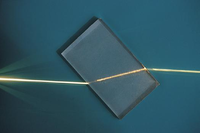
Photo from wikipedia
The present study was conducted to determine the effect of light conditions and chemical properties of water on dissipation of glyphosate. The residues of glyphosate and aminomethylphosphonic acid (AMPA) were… Click to show full abstract
The present study was conducted to determine the effect of light conditions and chemical properties of water on dissipation of glyphosate. The residues of glyphosate and aminomethylphosphonic acid (AMPA) were quantified using fluorescence spectrophotometer after derivatization with 9-fluoroenylmethoxycarbonyl chloride (FMOC-Cl) and orthopthaldehyde (OPA). Average percent recoveries of glyphosate and AMPA from distilled, tap, and ground water ranged from 87.5 to 94.9, 87.3 to 93.7, and 80.6 to 92.0, respectively, with relative standard deviation less than 10%. The limit of detection and limit of quantification of glyphosate and AMPA from different water matrices ranged from 0.001 to 0.03 μg mL−1 and 0.003 to 0.01 μg mL−1, respectively. The dissipation of glyphosate followed the first-order kinetics, and half-life varied from 1.56 to 14.47 and 13.14 to 42.38 days under UV and sunlight, respectively. The pH and electrical conductivity (EC) of water has differential influence on dissipation of glyphosate, and it increased with increase in pH and EC.
Journal Title: Environmental Monitoring and Assessment
Year Published: 2017
Link to full text (if available)
Share on Social Media: Sign Up to like & get
recommendations!